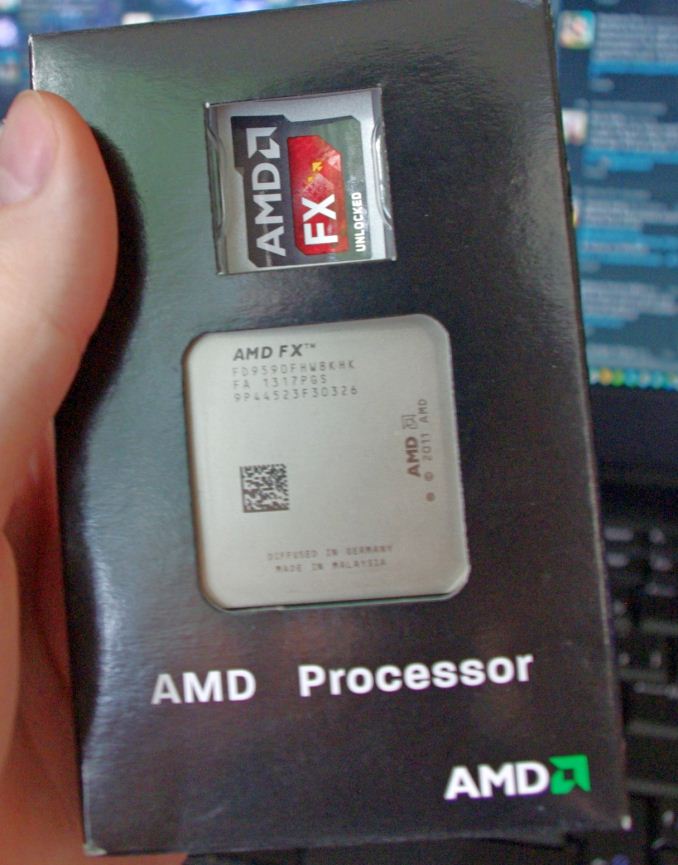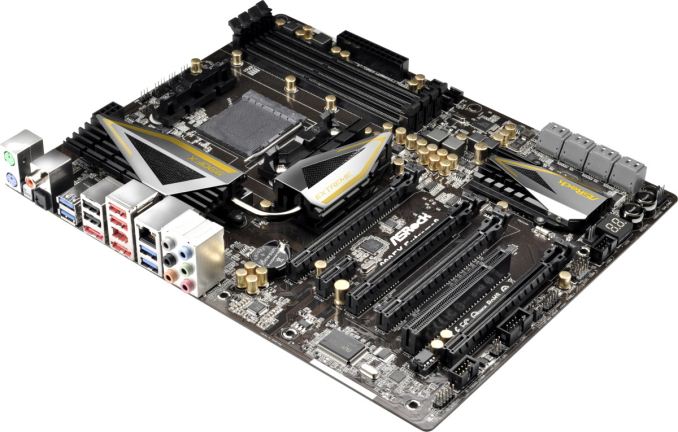AMD’s 5 GHz Turbo CPU in Retail: The FX-9590 and ASRock 990FX Extreme9 Review
by Ian Cutress on August 9, 2014 8:00 AM ESTThe AMD FX-9590
The analysis in this review shows that even a year after the OEM release of the FX-9590, and almost two years from the architecture coming to market it remains AMD’s performance part. If power consumption is not a concern, as a CPU compute and an AMD gaming CPU (especially when considering SLI) the FX-9590 is the best choice at stock speeds. On that basis alone, it makes sense that AMD should actually release it as a retail part, assuming they have enough stock. One might argue that a user could buy an FX-8350 and overclock, but if our sample CPUs were anything to go by, a user needs a fair bit of luck. The FX-9590 guarantees a 5.0 GHz turbo with a warranty.
With the retail release of the CPU, that warranty might be based on using the water cooling provided for the lifetime of the CPU. One might argue that AMD had trouble finding enough dies that could reach the frequencies and voltages for the FX-9590, and hence the delay combined with selling the SKU in select markets only.
The FX-9590 is the same Piledriver architecture as the FX-8350, which in turn was used in the A10-5800K/A10-6800K APUs, codename ‘Trinity’ and ‘Richland’ respectively. Since then, AMD has launched the Steamroller architecture modifications in the form of Kaveri APUs. The difference between a PIledriver APU and a similar frequency Steamroller APU, if we put aside the move from 32nm SOI to 28nm SHP, is around 10% for CPU performance. If that was shifted into a four-module, eight-thread CPU, it would surely be AMD’s performance part. The issue here is that AMD has almost discarded the high CPU performance arena in favor of integrated graphics. From Trinity to Kaveri, the IGP inside those APUs has improved considerably, indicating where AMD is investing its research dollars.
AMD clearly still cares about the performance market, otherwise this retail FX-9590 with water cooling would have never been pushed through to retailers. The high power consumption, the lack of a modern chipset, and the comparison to Intel CPUs in single threaded benchmarks are the main barriers to adoption. If AMD is to return to the performance market, the power consumption has to be comparable to Intel, or if it is slightly higher, the chipset has to offer something Intel cannot. Any suggestions for what that feature should be should be submitted on a postcard/in the comments.
ASRock 990FX Extreme9 Conclusion
One of the big issues surrounding AMD motherboards is their price sensitive nature. With an Intel based product, a $250-$400 motherboard is common enough to signify the expense in research or extra features. Because the AMD ecosystem, even in the high performance segment, is a cost sensitive market there is little room to move. For example, this year sees the first overclocking based motherboard for AMD APUs since the AM3+ era. So at $170, the Extreme9 could arguably be described as ‘limited’ compared to Intel standards.
The motherboard itself has specified support for 220W CPUs, something other motherboards either fail to mention or advise against completely. The native SATA 6 Gbps ports were ahead of Intel at the time, plus ASRock adds in another SATA 6 Gbps controller for good measure.
The eight USB 3.0 ports makes the Extreme9 have more USB 3.0 ports than almost every other 990FX/AM3+ motherboard ever released. This is combined with plenty of legacy support, such as separate PS/2 connectors, a PCI slot, an IEEE1394 port and an IEEE1394 header. The Intel NIC is paired with a Realtek ALC898 codec, with the PCIe layout aimed at 3-way GPU users for both Crossfire and SLI.
Aside from an updated chipset, if we were building a high-end AM3+ motherboard in 2014, I would insist on WiFi support and an upgraded audio codec to the ALC1150 at the minimum. We cannot get around the lack of PCIe 3.0 support, although moving the CPU modules from Piledriver to Steamroller along with the IO support might help with that. If we are being greedy with what we would like, I would add in M.2 support as well.
There is plenty to speculate if AMD had kept updating their high-end performance CPU line, even if the socket was not updated. As it stands, users who want SLI either look back to 990FX or invest in Intel. Users who want high multithreaded CPU performance either look back to 990FX or invest in Intel. Users who do not want processor graphics either look back to 990FX, buy an APU with the graphics disabled, or invest in Intel. AMD clearly does care about the performance market, or at least someone senior in the company does.












146 Comments
View All Comments
Flunk - Saturday, August 9, 2014 - link
The likelyhood of an existing AM3+ owner having a board that can support a 250watt CPU is pretty low, there really aren't many options. This CPU is a real turkey and people are not buying them.TiGr1982 - Saturday, August 9, 2014 - link
220 W, not 250, but this does not change your statement :)basroil - Sunday, August 10, 2014 - link
220W TDP, the chart above shows it uses 237W without overclocking! AMD needs to get their stuff togethertakeship - Sunday, August 10, 2014 - link
Yeah, AMD's "220" is 220w of heat, not necessary 220w of power. You'll measure more, maybe a lot more, at the wall.Death666Angel - Sunday, August 10, 2014 - link
That is the whole system, the mainboard, the drives, dedicated graphics card, conversion loss by your PSU. Get your facts straight.@takeship: Where would that 220W of heat come from is not from the power? Does the CPU somehow produce more heat from chemical reactions?
anubis44 - Sunday, August 10, 2014 - link
Well, one pro is that you get a processor that is fairly comparable to an Intel i7 in performance, and most importantly, you'll be giving your money to a company that didn't try to screw you by attempting to corner the market through extortionate threats to their own OEM customers if they used AMD CPUs when they were better than Intel's.In other words, there may not be any technical advantages over Intel's competing products, but there are also no significant disadvantages, and at least by buying AMD, you won't feel like you need to take a bath afterwards to wash the filth off. I say to hell with Intel. Stop giving them money as punishment for their gangsterism.
asoltesz - Wednesday, August 13, 2014 - link
Mostly, this is why I bought an AMD desktop last year. It was similar in price than an Intel-one would have been for the same money. It consumes much more energy but that was something I could put up with.FITCamaro - Saturday, August 9, 2014 - link
Man I seriously don't want to live in England if your electricity is that expensive. That's $0.30 cents/kWh. But with our current president and administration who want our electricity prices to rise, we might soon be in that boat. I pay about $0.06/kWh.lkb - Saturday, August 9, 2014 - link
Here in germany we pay 54 Euro Cents/kWh during peak times. While it sucks it has it upsides too - no stupid bitcoin mining crazy to speak of around here!TiGr1982 - Saturday, August 9, 2014 - link
Well, then I doubt you will go with FX - even despite the fact, that FX CPU dies are actually produced in Germany at Drezden GloFo Fab 1 :)